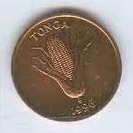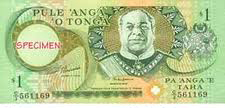|


The paʻanga is the currency of the Tonga. It is controlled by National Reserve Bank of Tonga (Pangikē Pule Fakafonua ʻo Tonga) in Nukuʻalofa. The paʻanga is not convertible and is pegged to a basket of currencies comprising the Australian, New Zealand, and United States dollars and the Japanese yen.
The paʻanga is subdivided into 100 seniti. The ISO code is TOP, and the usual abbreviation is T$ (¢ for seniti). In Tonga the paʻanga is often referred to in English as the dollar and the seniti as the cent. There is also the unit of hau (1 hau = 100 paʻanga) but this is not used in every day life and can only be found on commemorative coins of higher denominations.
Etymology
Entada scandens, native name paʻanga, is a bean-like vine producing large pods with large reddish brown seeds. The seeds are roundish, up to 5 cm diameter and 1 or 2 cm thick. When strung together they are used as anklets, part of the kailao dance costume. They were also used as playing pieces in an ancient disc-throwing game, lafo.
On 1 December 1806 Tongans attacked the passing ship Port-au-Prince in order to take it over. They failed, as the crew sank the vessel. The chief of Haʻapai, Fīnau ʻUlukālala, resorted to the next plan, plunder what ever was worthwhile. On his inspection tour he found the ship's cash. Not knowing what money was he considered the coins as paʻanga. Finally, not seeing anything of value, he ordered the remains of the ship to be burned. It was much later that William Mariner, the only survivor of this attack, told him that those pieces of metal were of great value and not merely playing stones.
When Tonga introduced decimal currency, it decided not to call the main unit the dollar because the native word, tola, translated into a pig's snout, the soft end of a coconut, or, in vulgar language, a mouth. Pa'anga, on the other hand, translated into money.
Mariner also passed down the following statement of Fīnau ʻUlukālala:
If money were made of iron and could be converted into knives, axes and chisels there would be some sense in placing a value on it; but as it is, I see none. If a man has more yams than he wants, let him exchange some of them away for pork. [...] Certainly money is much handier and more convenient but then, as it will not spoil by being kept, people will store it up instead of sharing it out as a chief ought to do, and thus become selfish. [...] I understand now very well what it is that makes the papālangi [white men] so selfish — it is this money!
History
The paʻanga was introduced on 3 April 1967. It replaced the pound at a rate of 1 pound = 2 paʻanga. Until 11 February 1991, the pa'anga was pegged to the Australian dollar at par. Since that time, a basket of currencies is taken (see above) and the paʻanga has continuously declined. As in 2006, one needs about T$1.60 to get 1 Australian dollar. Official exchange rates are released daily by the National Reserve Bank, established 1 July 1989, but rather towards the end of the day than early in the morning. In practice, it seems, that the real exchange rate is rather determined by the fancy of the higher echelons than the basket.
Coins
2 paʻanga coin depicting Taufa'ahau Tupou IV in military uniform.
In 1967, coins were introduced in denominations of 1, 2, 5, 10, 20 and 50 seniti and 1 paʻanga. The 1 and 2 seniti were struck in bronze with the other denominations in cupro-nickel. The 50 seniti and 1 paʻanga were only struck in small numbers as these denominations were also issued in note form. In 1974, dodecagonal 50 seniti were introduced but 50 seniti banknotes continued to be issued until 1983.
The later 1 and 2 Pa'anga coins issued saw the 1 Pa'anga coins being the worlds first rectangular coins to circulate. The 2 Pa'anga (depicted on the right) was round. The reverses of both were changed annually to commemorate a different FAO goal or event. However, due to the 2 Pa'anga coin's large size and weight and the 1 Pa'angas awkward shape, they failed to compete against the 1 and 2 Pa'anga notes that were simultaneously issued. They still remain legal tender but are very rarely used. Circulating strikes for both denominations were discontinued after 1981.
Current circulating coins are in denominations of 1, 2, 5, 10, 20 and 50 seniti. The one and two seniti coins are becoming less common nowadays, as they lose value due to a yearly inflation of about 11%, and are only readily available for some months after a release by the bank. Total prices in shops are usually rounded to the nearest 5 or 10 seniti, although some shops believe that to round means always to round up.
The first series of coins showed Queen Salote Tupou III, two years after her death. The reverse designs were a giant tortoise on the 1 and 2 seniti, wheat sheaves and stars on the 5 and 10 seniti, and the Tongan coat of arms on the higher denominations. From 1968, the portrait of King Taufa'ahau Tupou IV appeared, facing right. Since 1975, all coins have borne the word "Tonga" on the obverse and the inscription "Fakalahi meʻakai" (Tongan: "Grow more food") and the denomination on the reverse.
Banknotes
In 1967, notes (bearing the portrait of Queen Salote Tupou III) were introduced by the government in denominations of ½, 1, 2, 5 and 10 paʻanga. From 1974, the portrait of King Taufa'ahau Tupou IV appeared on the notes. ½ paʻanga notes were issued until 1983, with 20 paʻanga notes introduced in 1985, followed by 50 paʻanga in 1988. In 1992, the National Reserve Bank of Tonga took over production of paper money. On 30 July 2008 a 100 paʻanga paper issue was introduced
The obverse of the notes features text in the Tongan language and shows the portrait of King Taufa'ahau Tupou IV. The reverse is in English language and shows typical motives and landmarks of Tonga: the Haʻamonga ʻa Maui Trilithon, the royal palace, the Tongan Development Bank, the Port of Vavaʻu (twice, once as it was around 1900, and the other contemporary), and ngatu making.
The text on this page has been made available under the Creative Commons Attribution-ShareAlike License and Creative Commons Licenses
|
